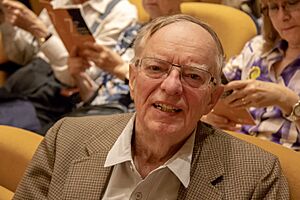Leonardo Balada facts for kids
Leonardo Balada Ibáñez (born September 22, 1933) is a famous Spanish-American composer. He is well-known for creating operas and music for orchestras.
Contents
Life of a Composer
Balada was born in Barcelona, Spain. He loved music from a young age. He studied piano at a music school in Barcelona.
Moving to America
In 1956, Balada moved to the United States. He received a special scholarship to study music at the New York College of Music. Later, he went to the Juilliard School in New York. He graduated from Juilliard in 1960.
While studying, he learned from important composers. These included Vincent Persichetti, Alexandre Tansman, and Aaron Copland. He also learned how to lead an orchestra from Igor Markevitch. In 1981, he became a citizen of the United States.
Teaching Music
Balada shared his knowledge with many students. He taught at Carnegie Mellon University in Pittsburgh, Pennsylvania. He started teaching there in 1970. He retired from teaching in 2020.
Some of his notable students include John Zorn and Hankus Netsky. He also taught music composition courses in Spain. From 2010 to 2020, he taught at the Universitat Politècnica de València. Students who won a special prize had their music performed for the first time.
Balada's Music Style
Leonardo Balada's music changed over time. In the early 1960s, his music was like neoclassicism. This style often used older musical ideas in new ways.
Exploring New Sounds
By 1966, Balada wanted to try something different. He started creating more modern and experimental music. An example from this time is his work Guernica.
Around 1975, his music changed again. He began mixing folk dance rhythms with his modern techniques. Folk music often uses traditional melodies and rhythms. His later works combined these with more experimental sounds.
Combining Old and New
In his mature music, Balada blended different harmonies. He used the familiar sounds of folk music. He also used atonality, which means music without a clear key or center. This mix made his music unique.
Pieces like Homage to Sarasate and Homage to Casals show this style. Balada's music always has interesting rhythms. It also uses instruments in special ways. This often creates a mysterious or thoughtful mood. Some of Balada's music has been recorded by Naxos Records.
Main Musical Works
Balada has composed many different types of music. Here are some of his most well-known pieces.
Operas
- Hangman, Hangman! (1982)
- Zapata (1984)
- Christopher Columbus (1986)
- Death of Columbus (1996)
- The Town of Greed (1997)
- Faust-bal (2007)
- Resurrection of Columbus (2013)
Orchestral Music
- Symphonies
- Symphony No. 1 Sinfonia en Negro (1968) - a tribute to Martin Luther King
- Symphony No. 2 Cumbres (1972) - for a band
- Symphony No. 3 Steel Symphony (1972)
- Symphony No. 4 Lausanne (1992)
- Symphony No. 5 American (2003)
- Symphony No. 6 Symphony of Sorrows (2005)
- Guernica (1966)
- Homage to Sarasate (1975)
- Homage to Casals (1975)
- Sardana (1979)
- Quasi un Pasodoble (1981)
- Fantasias Sonoras (1987)
- Zapata: Images for Orchestra (1987)
- Columbus: Images for Orchestra (1991)
- Divertimentos (1991) - for string orchestra
- Celebracio (1992)
- Folk Dreams (1994-8)
- Passacaglia (2002)
- Prague Sinfonietta (2003)
Concertos (Music for Solo Instrument and Orchestra)
- Piano
- Piano Concerto No. 1 (1964)
- Piano Concerto No. 2 (1974) - for piano, winds, and percussion
- Piano Concerto No. 3 (1999)
- Violin
- Violin Concerto No. 1 (1982)
- Caprichos No. 2 (2004)
- Caprichos No. 3 (2005)
- Viola
- Viola Concerto (2009–2010) - for viola and wind instruments
- Cello
- Cello Concerto No. 1 (1962) - for cello and nine other players
- Cello Concerto No. 2 New Orleans (2001)
- Concerto for Three Cellos and Orchestra A German Concerto (2006)
- Flute
- Morning Music (1994) - for flute and orchestra
- Music for Flute and Orchestra (2000)
- Clarinet
- Caprichos No. 7 (2009) - for clarinet and other instruments
- Guitar
- Guitar Concerto No. 1 (1965)
- Sinfonia Concertante for Guitar and Orchestra Persistencies (1974)
- Concerto for Four Guitars and Orchestra (1976)
- Concierto Mágico (1997) - for guitar and orchestra
- Caprichos No. 1 (2003)
- Other Instruments
- Concerto for Bandoneon and Orchestra (1970)
- Concertino for Castanets and Orchestra Three Anecdotes (1977)
- Music for Oboe and Orchestra Lament from the Cradle of the Earth (1993)
- Double Concerto for Oboe, Clarinet and Orchestra (2010)
Vocal and Choral Music
- Maria Sabina (1969)
- La Moradas (1970)
- No-res (1974)
- Ponce de Leon (1974) - for a narrator and orchestra
- Torquemada (1980)
- Thunderous Scenes (1992)
- Dionisio: In Memoriam (2001)
- Ebony Fantasies (2003) - a cantata
See also
 In Spanish: Leonardo Balada para niños
In Spanish: Leonardo Balada para niños


